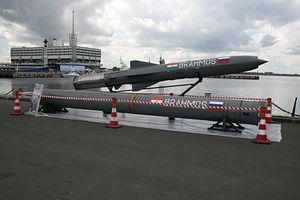Indian defense firm Larsen & Toubro (L&T) has inaugurated a new production line for BrahMos transport launch canisters (TLC) in Vadodara in the western state of Gujarat, India, the company announced on July 7.
The new facility manufactures airframes and TLCs for the land- and sea-launched variants of the supersonic BrahMos cruise missile. The new production line is L&T’s second BrahMos facility, with a third currently under construction in the southern city of Coimbatore in the Indian state of Tamil Nadu.
L&T’s announcement indicates a push by the Indian Ministry of Defense (MoD) to secure the uninterrupted serial production of one of India’s most advanced weapons systems, a joint venture between India’s Defense Research Development Organization (DRDO) and Russian rocket design bureau NPO Mashinostroyeniya,
The two-stage BrahMos missile — named after the Brahmaputra River in India and the Moskva River in Russia – is a derivative of the Russian-made P-800 Oniks over-the-horizon supersonic anti-ship cruise missile.
The land-launched and sea-launched variants of the BrahMos missile are already in operational with the Indian Army and Navy. An air-launched variant is slated to enter service with the Indian Air Force by the end of 2018.
As I reported previously:
The air-launched version is lighter (2.55 tons) than other variants and features additional rear fins for aerodynamic stability. The missile’s range is estimated at around 290 kilometers (180 miles). (…) With top speeds of Mach 2.8 to 3, the BrahMos is thought to be the world’s fastest cruise missile currently in service.
The missile’s maximum operational range is estimated at around 300 to 400 kilometers.
India has pushed to indigenize various parts and subsystems of the BrahMos missile in recent years including a new indigenous seeker, first successfully tested in March 2018. For now, Russia still supplies the missile’s ramjet propulsion system and seeker technology, while India provides the inertial navigation system and fire control system.
The MoD’s research arm, DRDO, and the Indian Army last test fired a supersonic BrahMos cruise missile on May 24. Another test launch was conducted a little over 24 hours prior to May 24 test at the Integrated Test Range in Chandipur along the coast of Odisha.
Another BrahMos test launch to “validate service life extension,” according to Sudhir Kumar Mishra, the head of BrahMos Aerospace, will take place this month. The test-firing is aimed at increasing the BrahMos missile’s service life from 10 to 15 years, Mishra added.
L&T has also developed a Quadruple Canisterized Inclined Launcher for the BrahMos missile to be installed on Indian Navy surface warships. The company presented the QCIL prototype, designed to launch up to four BrahMos missiles in an inclined configuration, in early May.
































